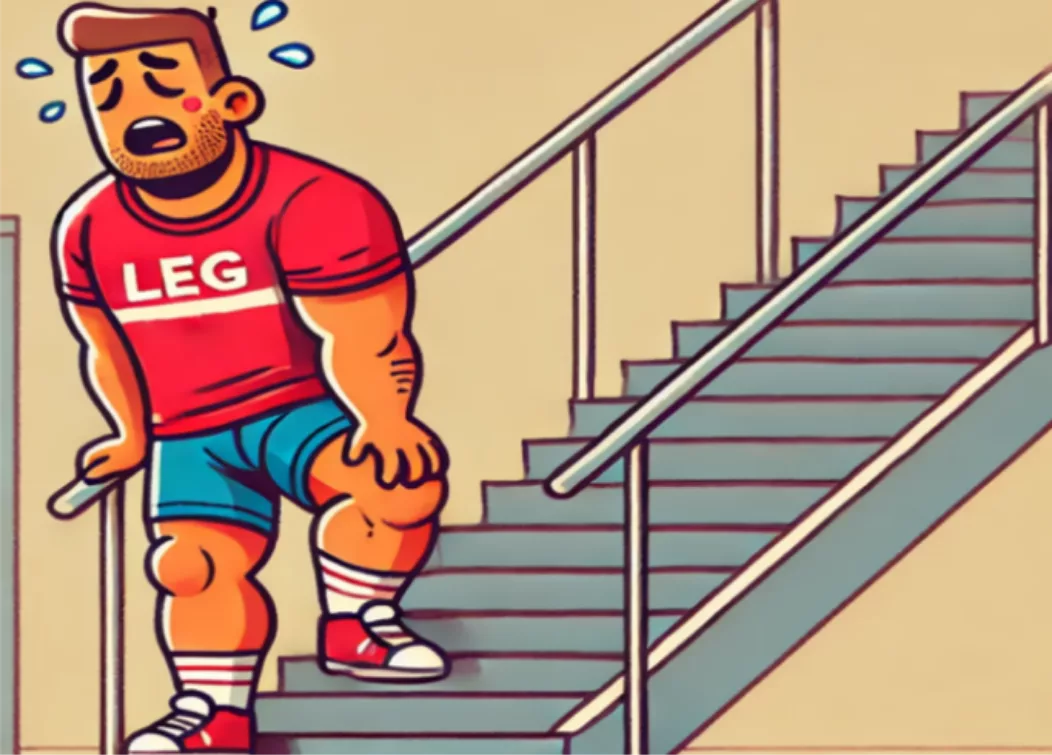They claim legs are built for walking, yet after having treated them to a brutal workout, I have my doubts.
After an hour of a challenging session, I discovered that even standing can be considered an extreme sport.
Every step was a challenge, every stair an humiliation.
If the stairs seem like divine punishment, know that you’ve done your duty.
The Main Exercises and the Muscles Involved
When it comes to leg day, one cannot fail to mention the dreaded squat, the leg press, and lunges.
These exercises are the true culprits behind the fatigue that leaves you stuck on the stairs.
The quadriceps contract as if they wanted to lift the entire world, while the glutes work tirelessly to give you that extra push.
Let’s not forget the hamstrings and calves, which engage with every step and, in the end, make you feel as if you were carrying a boulder.
Personally, every time I dive into a set of squats, I feel like a warrior in battle, knowing that every effort will turn into stronger muscles.
And then, when the next day the stairs seem like a mountain, I remind myself that “perseverance pays off.”
Post-Workout Pain

The pain you feel after leg day – that burning sensation that appears 24-48 hours later – is the famous DOMS (Delayed Onset Muscle Soreness).
It’s your body sending you a message: “Well done, you’ve done an exceptional job; now get ready to grow!”
It is a widespread pain that makes you feel stiff and heavy, but is actually a sign of muscle growth.
It is not a punishment, but the natural process of adaptation and repair of muscle fibers.
DOMS is the signal that your muscles are experiencing micro-tears, only to rebuild themselves more solidly.
In addition to that classic burn, you might notice other symptoms:
- Stiffness: Often you wake up in the morning with a feeling of tightness that makes even the simplest movements, like getting out of bed or turning in your sleep, difficult.
- Swelling: The muscles may appear slightly swollen or tight, almost as if they were “cooked” from the intense workout.
- Temporary Weakness: You might experience a momentary loss of strength, making everyday activities like climbing stairs or carrying heavy objects challenging.
- Mild Warmth: Sometimes the affected area may feel warm, due to increased blood flow during the muscle repair process.
DOMS or Injury?When the pain persists after leg day, it’s important to determine whether it’s the usual DOMS or something more serious. If the pain is sharp, localized, or does not improve with rest, you might be dealing not with DOMS, but with an injury. |
Tips for a Smart Leg Day
Targeted Warm-up
A solid warm-up is the secret weapon for a smart leg day.
Dedicate 10-15 minutes to get the muscles ready with bodyweight squats, walking lunges, and light jumps to minimize the risk of injury.
A few mini-sets before the main workout help fully activate the muscles.
Correct Technique
I prefer doing fewer repetitions with perfect form rather than hundreds with beginner technique.
Maintaining a straight back and engaged core protects against nasty leg pains the next day.
Gradual Progression
Gradually increase the load, because ‘Rome wasn’t built in a day.'”
This method prevents DOMS from turning into an untamable beast.
Exercise Variation
I alternate squats and deadlifts with static lunges and leg extensions to give the muscles a break.
As they say, “variety is the spice of life” – even at the gym!
Interval Management
Take strategic breaks between sets, because “there’s no rush; the important thing is arriving safe and sound.”
Control of the Eccentric Phase
Lower slowly to allow the muscles to better absorb the stress.
Cool-down and Stretching
After the workout, I allow myself 5-10 minutes of cool-down.
I walk slowly to lower my heart rate and then dedicate time to static stretching: quadriceps, glutes, calves, and back.
Each muscle is stretched gently, releasing residual tension and promoting optimal recovery.
These measures help reduce DOMS, resulting in legs that feel less “as hard as stone” in the morning.
How to Lessen the Pain the Day After
When I wake up the day after leg day, the stairs seem like a minefield.
But there are some tricks that help reduce the fatigue:
Active Recovery
There’s no need to remain stationary.
A light walk or a gentle bike ride promotes circulation and speeds up recovery.
Hydration and Nutrition
Drinking plenty of water and fueling up with foods rich in protein and antioxidants is essential.
A well-balanced post-workout meal helps repair muscle fibers.
Massages and Foam Rolling
A good massage or a foam rolling session works wonders.
Personally, I love that moment when I can “roll away” the tension.
Adequate Rest
A good night’s sleep is like a reset for the body.
Without proper rest, you risk accumulating fatigue and compromising progress.
Different Profiles, Different Pains
It’s interesting to note that the reaction to leg day is not the same for everyone.
Those who are young and fresh might feel less fatigued, while those who are older or less consistent with a regular routine might experience more pronounced fatigue.
Genetics also plays its part: some of us are built to endure better, while others need a bit more time to recover.
Knowing your body and accepting your peculiarities is part of the journey.
Furthermore, the intensity of the workout greatly affects the level of fatigue.
Extreme workouts, with heavy loads or many repetitions, can lead to deeper muscle micro-tears and more pronounced DOMS.
Conversely, less intense or well-balanced sessions promote quicker recovery and less marked fatigue.
At its core, matching exercise intensity to your fitness level is essential; staying alert to the body’s feedback and making load modifications ensures a smoother recovery for the next day.
Conclusion
It may seem paradoxical, but the fatigue after leg day is a positive sign.
It means that you have pushed your limits and that your body is working to become stronger.
So, struggling with the stairs after leg day is absolutely normal.
Don’t let fatigue discourage you: it is the fuel for growth and continuous improvement.
FAQs
How many days can DOMS last?
Generally, symptoms subside within 3-4 days, unless the workout was particularly intense.
Can I continue to work out if I have DOMS?
Yes, but with moderation. Active recovery, such as a light walk or yoga, can help maintain movement without aggravating the pain.
What role do supplements play in recovery?
Some supplements, such as omega‑3, turmeric, and antioxidants, can help reduce inflammation and promote muscle repair.
However, they are only a support: good nutrition and rest remain fundamental.
Is post‑workout massage really beneficial?
Absolutely.
A massage or the use of a foam roller can improve circulation, reduce muscle tension, and accelerate recovery.
Does applying ice help combat DOMS?
Ice is effective for reducing inflammation in the initial stages after a workout, but for DOMS that sets in 24-48 hours later, heat and massage are generally more beneficial.
Can compression garments also help?
Some studies suggest that compression garments can improve circulation and reduce inflammation, thereby easing DOMS. Results vary, but many athletes find benefit in using them as an additional support for recovery.


